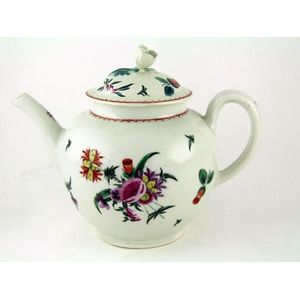Kangxi Blue & White Teapot with Prunus Blossom Design
You must be a subscriber, and be logged in to view price and dealer details.
Subscribe Now to view actual auction price for this item
When you subscribe, you have the option of setting the currency in which to display prices to $Au, $US, $NZ or Stg.
- Finial - An architectural decoration, found on the upper parts of of an object. On furniture they are usually found on pediments, canopies and shelf supports. On smaller ceramic or silver items, such as spoons, they may decorate the top of the item itself, or the lid or cover where they provide a useful handle for removal.
Finials have a variety of shapes and forms. They may be urn-shaped, baluster shaped round or spiral, but usually taper into an upper point. Many real life shapes may also be used as finials, such as pineapples, berries, pinecones, buds, lotus and acorns. Sometimes animals such as a lion are depicted, or fish and dolphins. - Ming Dynasty - The Ming Dynasty was a ruling dynasty of China from 1368 to 1644. It succeeded the Yuan Dynasty and preceded the Qing Dynasty. The Ming Dynasty was established by Zhu Yuanzhang, a former Buddhist monk who became a rebel leader and eventually overthrew the Mongol Yuan Dynasty. During the Ming Dynasty, China experienced a period of relative stability and prosperity. The government was centralized and bureaucratic, with the emperor at the top of the hierarchy. The Ming Dynasty is known for its cultural achievements, including the development of porcelain, the invention of movable type printing, and the construction of the Great Wall of China.
- Qing Dynasty - The Qing Dynasty was the last imperial dynasty of China, ruling from 1644 to 1912. It was established by the Manchu people, who originated from the northeastern region of China. The Qing Dynasty was preceded by the Ming Dynasty and followed by the Republic of China.
- Circa - A Latin term meaning 'about', often used in the antique trade to give an approximate date for the piece, usually considered to be five years on either side of the circa year. Thus, circa 1900 means the piece was made about 1900, probably between 1895 and 1905. The expression is sometimes abbreviated to c.1900.
This item has been included into following indexes:
- Chinese ceramics, decoration - blue and white, other 773
- Chinese ceramics, dynasty mark or period
- Chinese ceramics, item type - tea pots 301
- Chinese ceramics, shipwreck cargo - Kangxi shipwreck cargo 13
Visually similar items

A Dr Wall Worcester tea pot with flower finial and sprigs of flowers

A Dr Wall Worcester covered jug, circa 1770, pear shaped with a simple strap handle and beak spout and daintily painted in puce camaieu with sprays of flowers, insects, some within a scrolled gilt cartouche, the lid with an applied rose finial. Height 13.5

A Dr Wall Worcester teapot in 'Fence' pattern, circa 1770, the globular teapot with a moulded loop handle and a low domed cover with an applied flower and leaf finial; crescent mark underside and with original label from the Scott Museum collection, height

A fine Worcester pencilled 'Boy on Buffalo' teapot, circa 1754, the bullet shape teapot with a loop handle, painted in black upon white with a boy riding a buffalo below a trailing tree branch, the trunk encrusted with symbolic lingzhi fungus, the reverse
